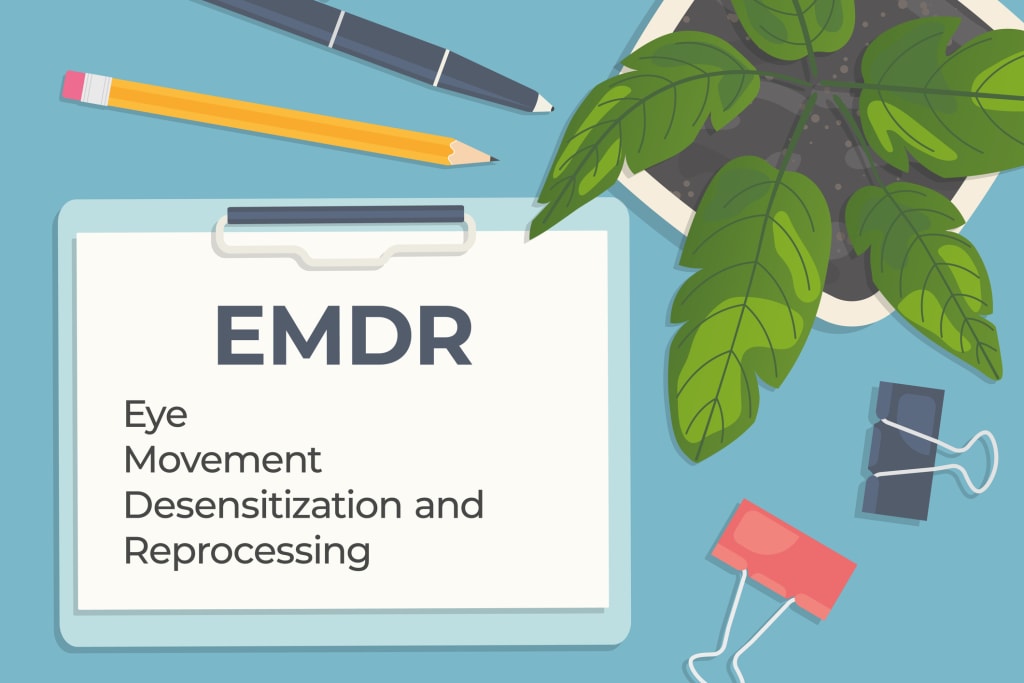My Journey With EMDR Therapy
Overcoming trauma from life on the front line

I sat in an office, watching a blue light move left and right. A therapist was asking me probing questions, trying to pull every agonizing detail of my trauma out of me.
Believe it or not, this is a form of therapy for PTSD. It’s called EMDR, which stands for Eye Movement Desensitization and Reprocessing.
I suffered trauma as a police officer, and this strange therapeutic practice would dictate whether I’d ever return to the job I loved.
A brief history of EMDR.
EMDR works on the theory that the mind acts like our physical body. When we bruise ourselves, our body tries to heal us. EMDR seeks to speed up the process of emotional healing in the same way. It resolves our emotional pain.
EMDR was developed by Dr Francine Shapiro in 1987 as an alternative treatment for PTSD. Shapiro recognized the effect of eye movements on traumatic memories. Her main focus was on the treatment of sexual assault victims and war veterans.
The core theme of EMDR is that the stress symptoms caused by trauma are due to incorrectly processed memories. It works on the theory that we don’t process trauma with the brain alone. Thus, when we experience triggers, our bodies and brains react like they did when the trauma occurred. There’s no distinction between the past and present.
EMDR helps process a memory to move past it. It changes how the memory is stored in the brain so that it loses the intense emotional reactions that form PTSD.
In practice, EMDR uses bilateral stimulation while the patient is experiencing the trauma in a safe environment to trigger the brain’s ability to heal. Usually, this is done by performing side-to-side eye movements while thinking of the trauma, which engages both sides of the brain.
Traditionally, it’s believed that it takes a long time to heal from trauma. However, EMDR can speed up the healing process.
How does EMDR work?
When we experience trauma and relive it, the rational part of our brain can’t control the emotional side. You end up triggered and can’t think properly.
Traumatic memories are stuck and occur in the present. They are unprocessed memories. When we sleep, we process memories. Every day memories don’t become stuck because they move to the correct part of the brain when we dream.
What happens during dream sleep also happens during EMDR. By the therapist moving your eyes from side to side while getting you to focus on a fractured, traumatic memory, you process that memory as you would if you were asleep.
My first experience with EMDR — sobbing in the therapy room.
It took time after my first trauma to be diagnosed with PTSD. During that time I carried on working as a police officer. When senior officers noticed how much I’d changed, they arranged for six sessions of EMDR.
The setting was pleasant. Claude welcomed me into his home, to his own office. As he was a private therapist and charging a lot of money, we had plants and relaxing pictures to look at. Even the seats were comfortable.
We spent two sessions going through what to expect, and he took notes on my background and trauma.
In the third session, the EMDR began. I had to sit and watch a moving blue light bouncing back and forth. At the same time, Claude would ask me to bring certain aspects of the trauma to my mind.
We did this for two sessions. I don’t remember much about it because it felt dreamlike, but he commented afterward that I didn’t just cry — I sobbed.
I left the six therapy sessions feeling better. The memories were no longer torturing me, and I felt like I’d recovered — almost cured. If I’d left the police at that time and not been subjected to any further traumas, I’m pretty sure I’d have been fine.
But that’s not how it went. I was eager to return to front-line policing, and the police force was keen to have me back. My therapist wrote a report that I was cured and fit for duty. And so, against the odds, I made my triumphant return.
It didn’t take long for trauma to pile on top of trauma. Now, I wasn’t just haunted by one tragedy, but dozens.
As I started to unravel again, I decided to pay for my therapy and keep it secret from the police. I planned to continue working alongside the treatment. It was a disastrous plan, but I didn’t know any better. All I knew was I had to be a police officer — it was in my blood. And I had to be on the front line.
And so, I began EMDR again — not with the initial therapist because he was a police referral only. This time, it was with Jo.
EMDR and cushion throwing.
I was so obsessed with keeping my job that I’d book therapy sessions and then go straight to work afterward. In hindsight, it was a terrible decision because EMDR can be traumatic, and I allowed myself no recovery time.
The problem was that I was now even more closed off about my traumas. It’s the catch-22 with PTSD — you have to talk about your trauma and confront it, but part of the illness is avoidance of triggers. It took me nearly 20 years to overcome this problem.
I forced myself to pick around the edges of my issues and managed to process some of the less severe traumas.
Jo combined EMDR with Cognitive Behavioural Therapy, so some sessions were talking. Sometimes, it’s natural to swallow during a conversation, but Jo didn’t see it like that. As a therapist, she had to have a unique interpretation of everything. She interpreted my swallowing as a sign I was repressing tears and about to start a flashback. To counter this, she threw cushions at me.
“CATCH!” she would shout before she continued the bombardment. “Now throw them back.” Everything is so dramatic with a therapist. I’d swallowed, and she thought I’d disassociated.
I left most sessions feeling irritated — especially as I’d paid for this nonsense.
The verdict.
Due to my insisting I remain a police officer, I became progressively more ill until I was forced to medically retire at age 27. The doctor told me I was 100% disabled for the rest of my life.
You might think this is proof that EMDR is useless — and I do think it’s overrated. Some therapists have told me they can cure even the worst cases in just six weeks, which I found to be garbage. There are a lot of big egos in the world of therapy.
But the truth is more complicated. EMDR worked well for me when I had one trauma to process. I’d have had a good life if I’d left the police at that stage and looked after myself.
EMDR was not suitable at all for multiple traumas. Having several traumas, all knotted together in my mind, was too much for EMDR to unpick. Not wanting to discuss my traumas didn’t help, but it was still so much easier the first time.
If you’re in a job where you’re exposed to trauma, and you recover, think yourself lucky and stop. Don’t push on like I did.
The consequences can be dire.
Download my FREE ebook, ‘Mental Health: Myths, Realities, and Hope.’ Discover the truth about mental illness, debunk common myths, and find resources for support.
About the Creator
Leon Macfayden
From a police officer to a psychiatric ward and recovery.
Grab my new FREE checklist for the top 5 books that will change your life starting today.
From fear and worry to courage and success.
Turn adversity into advantage.
Enjoyed the story? Support the Creator.
Subscribe for free to receive all their stories in your feed. You could also pledge your support or give them a one-off tip, letting them know you appreciate their work.






Comments
There are no comments for this story
Be the first to respond and start the conversation.